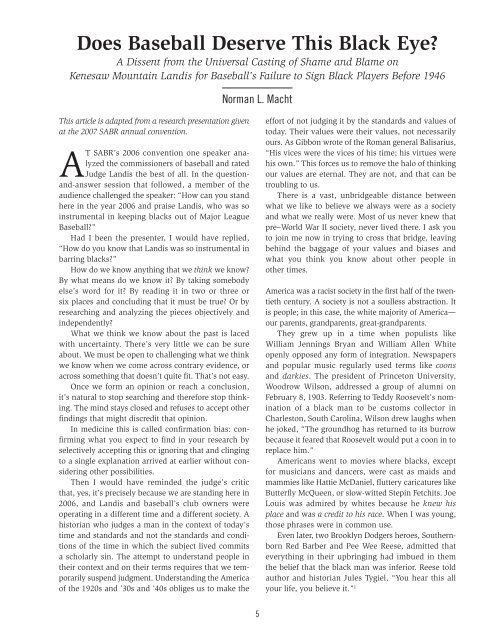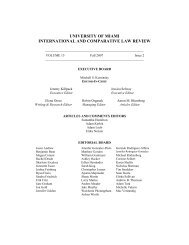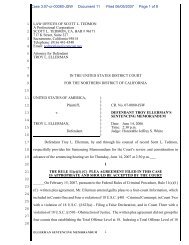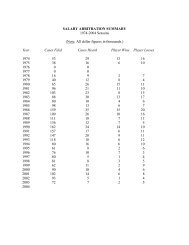Kenesaw Mountain Landis - SABR
Kenesaw Mountain Landis - SABR
Kenesaw Mountain Landis - SABR
Create successful ePaper yourself
Turn your PDF publications into a flip-book with our unique Google optimized e-Paper software.
Does Baseball Deserve This Black Eye<br />
A Dissent from the Universal Casting of Shame and Blame on<br />
<strong>Kenesaw</strong> <strong>Mountain</strong> <strong>Landis</strong> for Baseball’s Failure to Sign Black Players Before 1946<br />
Norman L. Macht<br />
This article is adapted from a research presentation given<br />
at the 2007 <strong>SABR</strong> annual convention.<br />
AT <strong>SABR</strong>’s 2006 convention one speaker analyzed<br />
the commissioners of baseball and rated<br />
Judge <strong>Landis</strong> the best of all. In the questionand-answer<br />
session that followed, a member of the<br />
audience challenged the speaker: “How can you stand<br />
here in the year 2006 and praise <strong>Landis</strong>, who was so<br />
instrumental in keeping blacks out of Major League<br />
Baseball”<br />
Had I been the presenter, I would have replied,<br />
“How do you know that <strong>Landis</strong> was so instrumental in<br />
barring blacks”<br />
How do we know anything that we think we know<br />
By what means do we know it By taking somebody<br />
else’s word for it By reading it in two or three or<br />
six places and concluding that it must be true Or by<br />
researching and analyzing the pieces objectively and<br />
independently<br />
What we think we know about the past is laced<br />
with uncertainty. There’s very little we can be sure<br />
about. We must be open to challenging what we think<br />
we know when we come across contrary evidence, or<br />
across something that doesn’t quite fit. That’s not easy.<br />
Once we form an opinion or reach a conclusion,<br />
it’s natural to stop searching and therefore stop thinking.<br />
The mind stays closed and refuses to accept other<br />
findings that might discredit that opinion.<br />
In medicine this is called confirmation bias: confirming<br />
what you expect to find in your research by<br />
selectively accepting this or ignoring that and clinging<br />
to a single explanation arrived at earlier without considering<br />
other possibilities.<br />
Then I would have reminded the judge’s critic<br />
that, yes, it’s precisely because we are standing here in<br />
2006, and <strong>Landis</strong> and baseball’s club owners were<br />
operating in a different time and a different society. A<br />
historian who judges a man in the context of today’s<br />
time and standards and not the standards and conditions<br />
of the time in which the subject lived commits<br />
a scholarly sin. The attempt to understand people in<br />
their context and on their terms requires that we temporarily<br />
suspend judgment. Understanding the America<br />
of the 1920s and ’30s and ’40s obliges us to make the<br />
effort of not judging it by the standards and values of<br />
today. Their values were their values, not necessarily<br />
ours. As Gibbon wrote of the Roman general Balisarius,<br />
“His vices were the vices of his time; his virtues were<br />
his own.” This forces us to remove the halo of thinking<br />
our values are eternal. They are not, and that can be<br />
troubling to us.<br />
There is a vast, unbridgeable distance between<br />
what we like to believe we always were as a society<br />
and what we really were. Most of us never knew that<br />
pre–World War II society, never lived there. I ask you<br />
to join me now in trying to cross that bridge, leaving<br />
behind the baggage of your values and biases and<br />
what you think you know about other people in<br />
other times.<br />
America was a racist society in the first half of the twentieth<br />
century. A society is not a soulless abstraction. It<br />
is people; in this case, the white majority of America—<br />
our parents, grandparents, great-grandparents.<br />
They grew up in a time when populists like<br />
William Jennings Bryan and William Allen White<br />
openly opposed any form of integration. Newspapers<br />
and popular music regularly used terms like coons<br />
and darkies. The president of Princeton University,<br />
Woodrow Wilson, addressed a group of alumni on<br />
February 8, 1903. Referring to Teddy Roosevelt’s nomination<br />
of a black man to be customs collector in<br />
Charleston, South Carolina, Wilson drew laughs when<br />
he joked, “The groundhog has returned to its burrow<br />
because it feared that Roosevelt would put a coon in to<br />
replace him.”<br />
Americans went to movies where blacks, except<br />
for musicians and dancers, were cast as maids and<br />
mammies like Hattie McDaniel, fluttery caricatures like<br />
Butterfly McQueen, or slow-witted Stepin Fetchits. Joe<br />
Louis was admired by whites because he knew his<br />
place and was a credit to his race. When I was young,<br />
those phrases were in common use.<br />
Even later, two Brooklyn Dodgers heroes, Southernborn<br />
Red Barber and Pee Wee Reese, admitted that<br />
everything in their upbringing had imbued in them<br />
the belief that the black man was inferior. Reese told<br />
author and historian Jules Tygiel, “You hear this all<br />
your life, you believe it.” 1<br />
5








